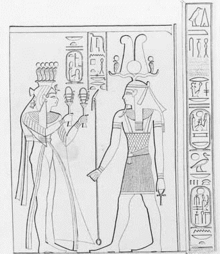Iset Ta-Hemdjert
Iset Ta-Hemdjert or Isis Ta-Hemdjert, simply called Isis in her tomb, was an ancient Egyptian queen of the Twentieth Dynasty; the Great Royal Wife of Ramesses III and the Royal Mother of Ramesses VI.[1]
| Iset Ta-Hemdjert | |||||
|---|---|---|---|---|---|
| Queen consort of Egypt | |||||
 Queen Isis in the Valley of the Queens | |||||
| Burial | QV51 | ||||
| Spouse | Pharaoh Ramesses III | ||||
| Issue | Ramesses VI | ||||
| |||||
| Dynasty | 20th Dynasty of Egypt | ||||
| Father | unknown | ||||
| Mother | Hemdjert | ||||
| Religion | Ancient Egyptian religion | ||||

| Iset Ta-Hemdjert in hieroglyphs |
|---|
She was probably of Asian origin; her mother's name Hemdjert (or Habadjilat or Hebnerdjent) is not an Egyptian name but a Syrian one.[2] One of her children are known to us, Ramesses VI, who succeeded his nephew Ramesses V, the short-lived son of Ramesses IV. Other than Ramesses V, the grandchildren of Iset Ta-Hemdjert include Ramesses VII, the God's Wife of Amun Iset, and princes Amunherkhopsef and Panebenkemyt; these are all the children of Ramesses VI.[1] Ramesses IV was once thought to be this queen's own son too until it was revealed in a recent 2010 Journal of Egyptian Archaeology article that Queen Tyti was most likely to be this king's mother from copies of fragments of the tomb robbery papyri that Anthony Harris made revealing that she was Ramesses III's own wife plus the fact that she is known to have been a king's mother.[3]
Apart from the Great Royal Wife designation, she also held the titles of God's Wife, and, during the reign of her sons, "King's Mother". She is shown on a statue of Ramesses III in the Mut temple at Karnak. She was still alive during the reign of Ramesses VI, when her granddaughter Iset became God's Wife of Amun.
Tomb QV51
Isis Ta-Hemdjert was buried in the Valley of the Queens, in tomb QV51.[2] The tomb was described by Champollion, and is documented in Lepsius' Denkmahler. [4] The construction of the tomb may have started during the reign of her husband King Ramesses III, but it was finished during the reign of her son Ramesses VI. The tomb had been looted in ancient times and is mentioned in the papyri regarding the tomb robberies during the 20th Dynasty.[5]
The tomb consists of a corridor ending in a main hall with two side chambers. The corridor is decorated with scenes showing the queen before a variety of divinities including Ptah-Sokar, Atum and Osiris. [4]
The outer jambs for the main hall contain a text by Ramesses VI.[4] The queen appears before several gods, including Ptah. and hawk-god, the god Anhur-Shu and Atum.[4] The side rooms are decorated with scenes showing a variety of goddesses including Neith, Serket, Isis, and Nephthys. [4]
Fragments of a red granite sarcophagus were recovered during the excavations by Schiaparelli and are now in the Museo Egizio in Turin, Italy. [4]
References
- Aidan Dodson & Dyan Hilton, The Complete Royal Families of Ancient Egypt, (London: Thames & Hudson, 2004) ISBN 0-500-05128-3, pp.186-187
- Dodson & Hilton, p.192
- Mark Collier, Aidan Dodson, & Gottfried Hamernik, P. BM EA 10052, Anthony Harris, and Queen Tyti, JEA 96 (2010) pp.242-246
- Porter, Bertha and Moss, Rosalind, Topographical Bibliography of Ancient Egyptian Hieroglyphic Texts, Statues, Reliefs and Paintings Volume I: The Theban Necropolis, Part 2. Royal Tombs and Smaller Cemeteries, Griffith Institute. 1964, pg 756
- Demas, Martha, and Neville Agnew, eds. 2012. Valley of the Queens Assessment Report: Volume 1. Los Angeles, CA: Getty Conservation Institute. Getty Conservation Institute, link to article
External links
- Tomb of Queen Ese Plan and description of the tomb